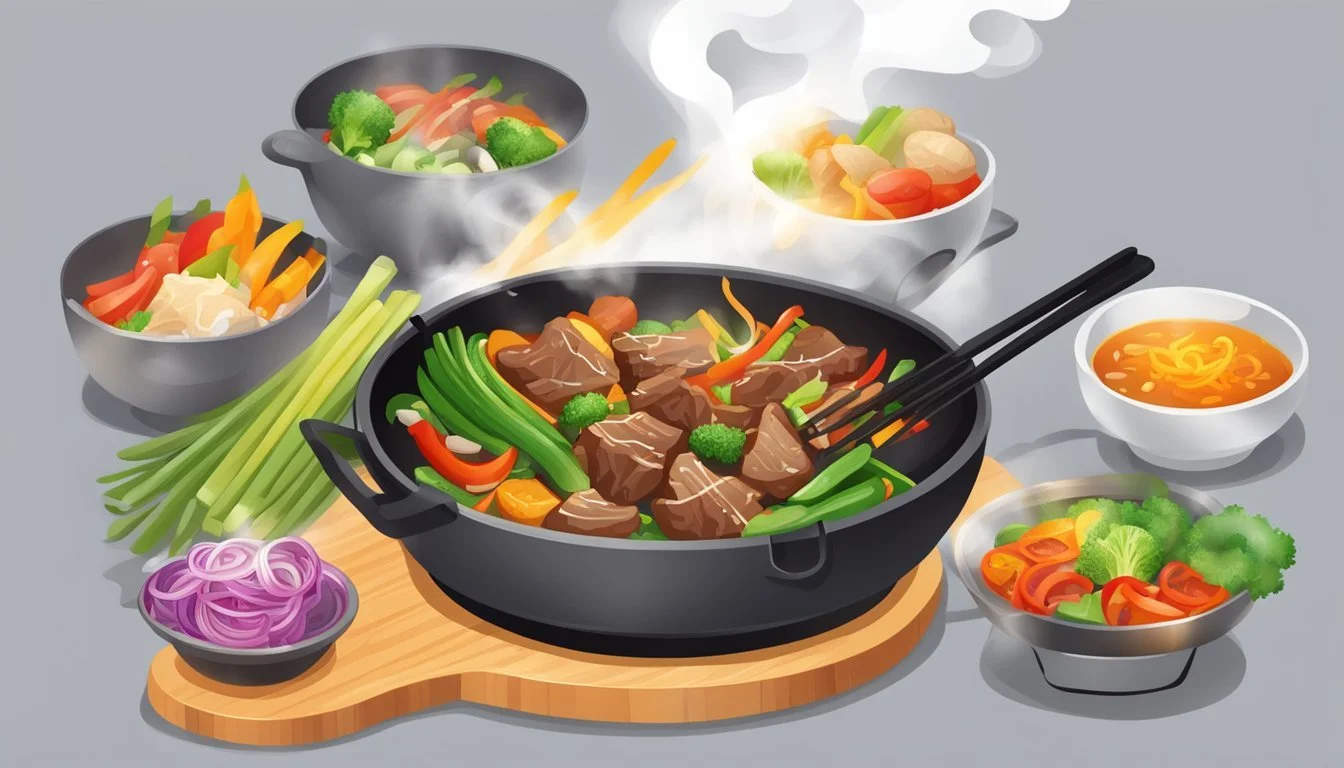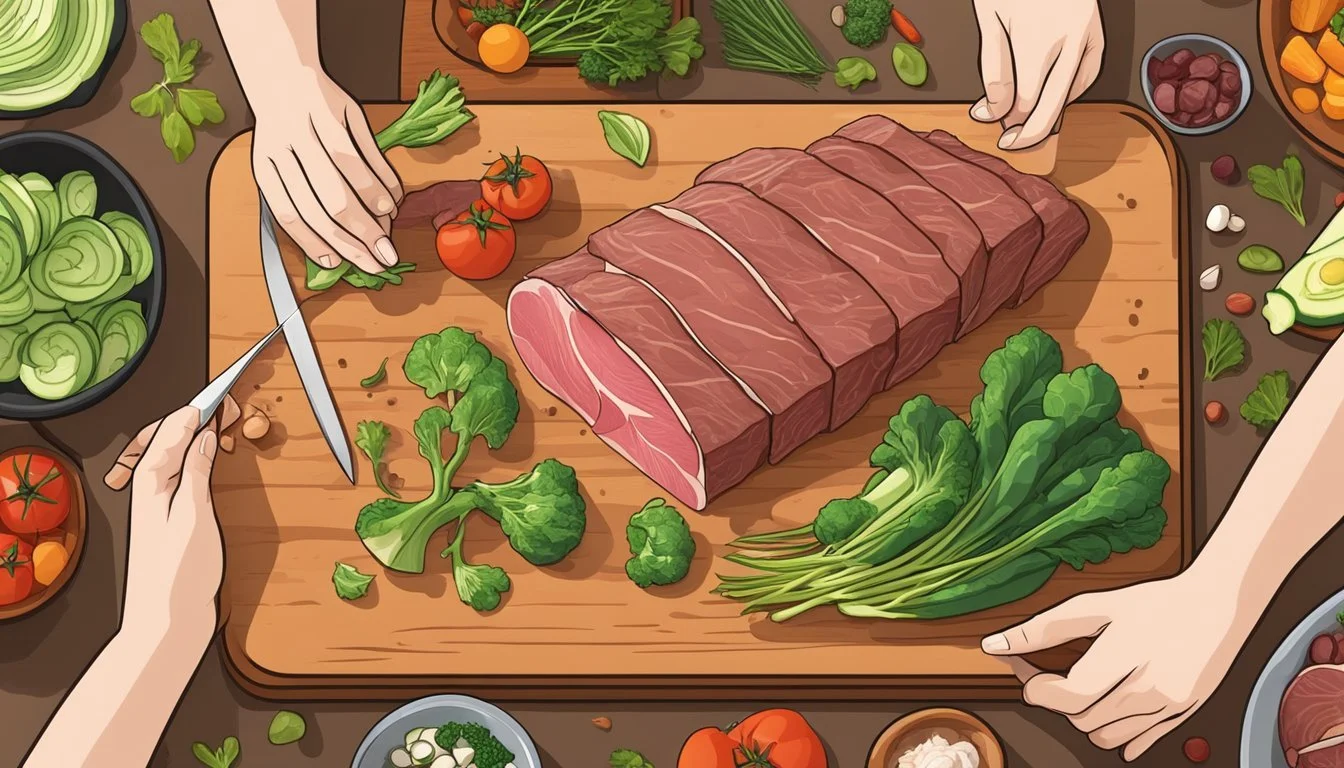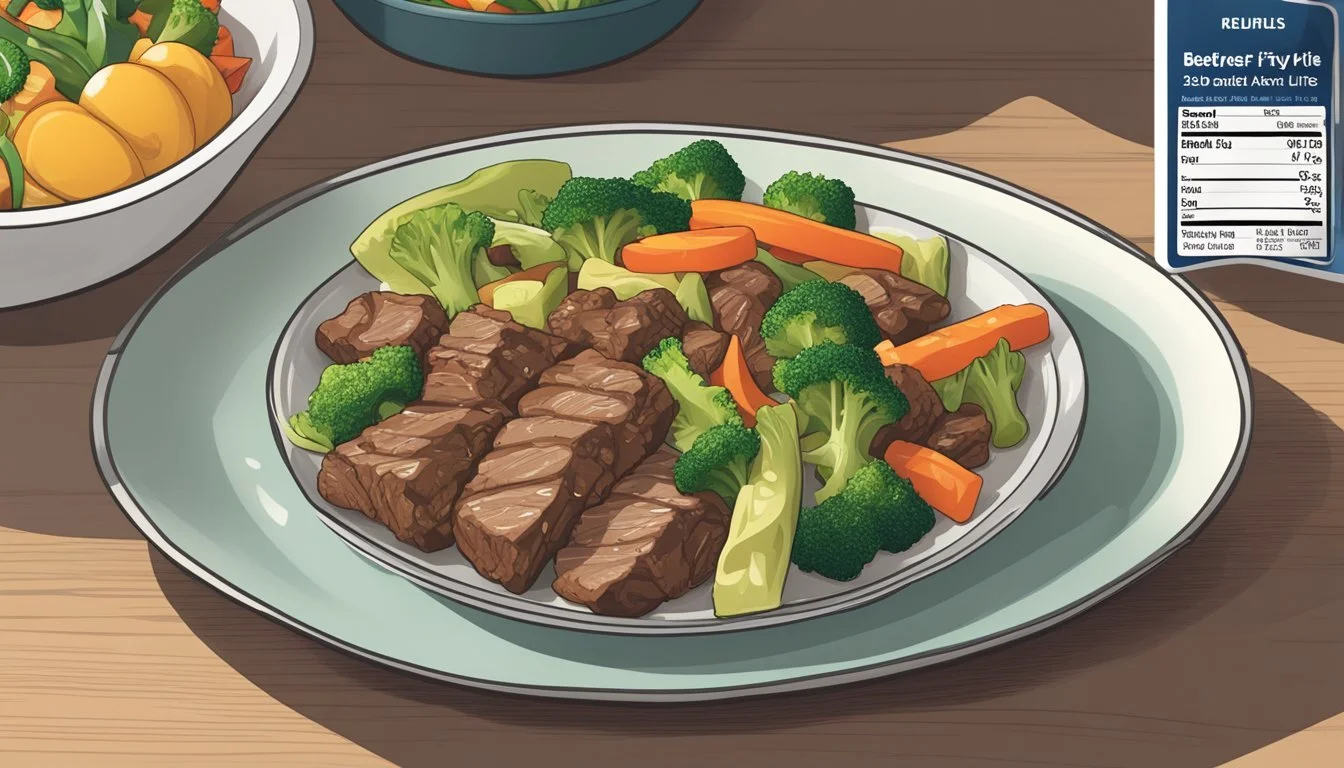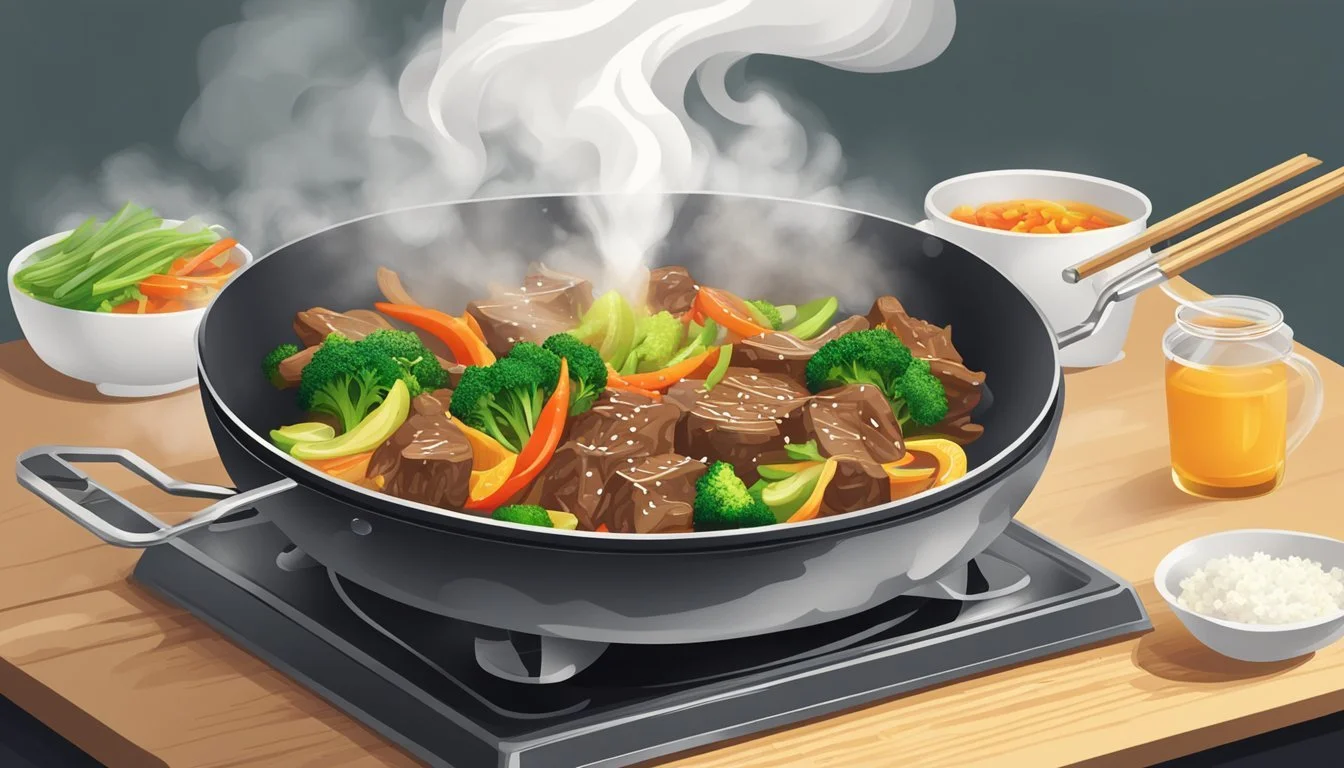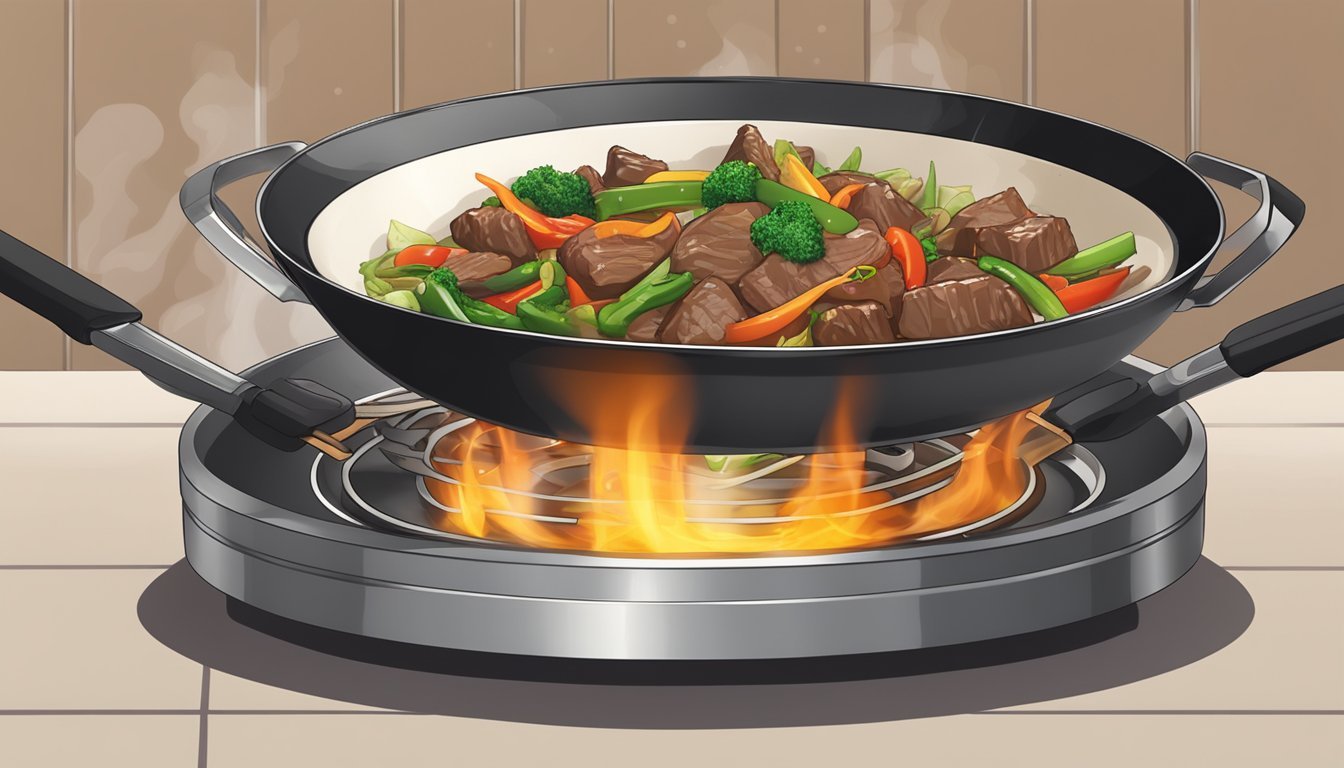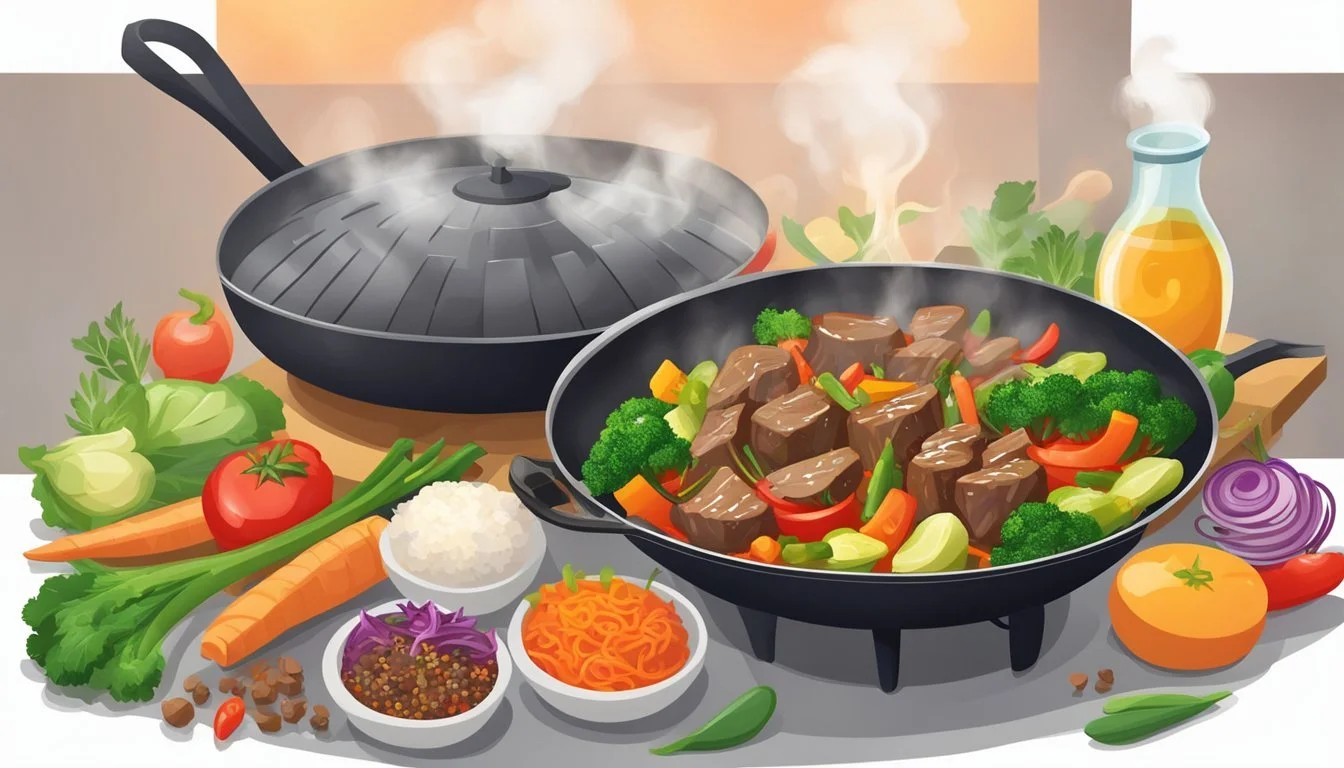How Long Does Beef Stir-Fry Last?
Storage Tips and Safety Guidelines
Beef stir-fry is a delicious and quick meal option many people enjoy making at home. Properly stored beef stir-fry can last for about 3 to 4 days in the refrigerator. If you find yourself with leftovers, consider freezing it to extend its shelf life.
Storing your stir fry correctly is crucial to maintaining its flavor and safety. Place your leftovers in an airtight container and make sure your refrigerator is set to 40°F (4°C) or below to reduce the risk of bacterial growth. When reheating, ensure the beef reaches an internal temperature of 165°F (74°C) to keep it safe for consumption.
Remember, good storage habits and proper reheating are key to enjoying your beef stir-fry leftovers without any concerns about foodborne illness. Beef stir-fry can retain its taste and nutritional value when handled appropriately, making it a convenient and tasty option even for days after cooking.
Beef Stir-Fry Basics
Beef stir-fry is a quick, versatile dish that combines tender beef with a variety of vegetables, typically cooked in a hot wok or skillet. The cooking method emphasizes fast, high-heat cooking to sear the ingredients and lock in flavors.
Ingredients
Vegetables (e.g., bell peppers, broccoli, snap peas)
Oil: Use a high smoke point oil like vegetable, canola, or peanut oil.
Soy Sauce: Adds saltiness and umami to the marinade.
Optional: Garlic, ginger, chili peppers for extra flavor
Preparing the Beef
For a tender stir-fry, it is essential to prepare the beef properly. Marinate the beef with soy sauce, cornstarch, and a teaspoon of baking soda to retain moisture and tenderness. Let it sit for 1-2 hours.
Cooking
Heat the wok or skillet over high heat.
Add a tablespoon of oil and let it get very hot.
Add the beef in a single layer and sear for 2-3 minutes without stirring.
Stir, and cook until almost done, about 1-2 more minutes.
Transfer the beef to a bowl.
Adding Vegetables
In the same pan, add vegetables and stir-fry for 3-4 minutes until they are tender-crisp. You may need to add more oil if the pan is dry.
Combining and Finishing
Return the beef to the pan and mix with vegetables.
Add a sauce made of soy sauce, a little water, and optional sugar or honey for sweetness.
Stir and cook until everything is well-coated and heated through, about 1-2 minutes.
Beef stir-fry is quick and can be easily customized to suit different tastes and preferences, making it a staple in many households.
Choosing the Right Ingredients
Selecting the best ingredients is crucial for making a delicious beef stir-fry. The quality and type of beef, vegetables, and seasonings greatly impact the final taste and texture of the dish.
Selecting the Beef
Choosing the right cut of beef is essential for a tender and flavorful stir-fry. Cuts like sirloin and flank steak are popular choices due to their tenderness and ability to absorb marinades well.
Thinly slice the beef across the grain to enhance tenderness. A marinade using ingredients like cornstarch and wine vinegar helps in tenderizing the beef and boosting its flavor. Avoid using frozen beef, as it can result in a chewy texture.
Vegetable Varieties
The choice of vegetables can significantly influence the flavor and nutritional value of your beef stir-fry. Common vegetables include broccoli, carrots, bell peppers, and onions. Adding green onions and garlic provides additional aromatic flavors.
Cut all vegetables into uniform, bite-sized pieces to ensure even cooking. Blanching harder vegetables like broccoli and carrots before stir-frying ensures they remain tender-crisp. Don't overcrowd the pan to avoid steaming the vegetables instead of stir-frying them.
Sauces and Seasonings
The sauce ties all the ingredients together and adds depth to the stir-fry. Oyster sauce, beef broth, and soy sauce are essential for a savory base. Additional seasonings like garlic and ginger enhance the flavor profile.
Thicken the sauce with cornstarch mixed in cold water for the right consistency. To add a finishing touch, garnish the stir-fry with sesame seeds and a splash of wine vinegar. Using a high-quality stir fry sauce can also enhance the dish's overall taste.
Selecting the correct ingredients and preparing them properly will result in a beef stir-fry that is both delicious and satisfying.
Nutritional Information
Beef stir-fry can be a nutritious meal option, offering a balance of protein, carbohydrates, and fat.
One cup of beef stir-fry typically contains 210-450 calories based on different sources. This variance depends on the ingredients and portion size.
Macronutrient Breakdown
Protein: Beef stir-fry is a good source of protein, usually contributing about 20-22% of the total caloric intake. For instance, a serving might provide 15-25 grams of protein.
Carbohydrates: Carbohydrates often make up the bulk of the calories, accounting for around 61-69%. This includes vegetables and any sauces used.
Fats: The fat content is relatively low, usually around 9-18% of the total calories. This can be influenced by the type of oil used in cooking.
Micronutrients
Fiber: The fiber content in beef stir-fry can vary, but vegetables like bell peppers, broccoli, and snap peas can provide dietary fiber.
Vitamins and Minerals: Ingredients commonly found in beef stir-fry, such as vegetables, can provide essential vitamins and minerals. These include Vitamin C, Vitamin A, potassium, and iron.
Sample Content Table
Nutrient Amount per Serving (1 cup) Calories 210-450 Protein 15-25 grams Carbohydrates 30-50 grams Fat 5-10 grams Fiber 2-4 grams
The specific nutritional values can vary based on the recipe and ingredients used. Always check the nutritional information provided by the recipe or product to ensure accuracy.
Preparing Beef Stir-Fry
To prepare beef stir-fry effectively, it's essential to focus on marinating the meat properly, using the right cooking techniques, and thoughtfully incorporating vegetables and sauce.
Marinating the Meat
Start by cutting beef chuck or a similar tender cut into thin, uniform slices. This ensures even cooking. Velveting is a key technique that involves marinating the beef in a mixture of cornstarch, egg white, and oil. This helps the beef remain tender and retain moisture during cooking.
In addition to velveting, a teaspoon of baking soda per pound of beef can further tenderize the meat. Let the beef marinate for at least 30 minutes to an hour. Proper marination infuses the beef with flavor and tenderness, which is crucial for a great stir-fry.
Cooking Techniques
Preheat a wok or large skillet over high heat until it's extremely hot. This step is important as it ensures the beef sears quickly without stewing in its own juices. Add a generous amount of oil and swirl to coat the bottom.
Spread the beef out in a single layer and cook for 2-3 minutes per side until it’s browned but not overdone. Overcooking can make the beef tough. Once done, remove the beef and set it aside. Blanching the beef before stir-frying can also aid in tenderizing by quickly denaturing the proteins.
Adding Vegetables and Sauce
Choose colorful veggies like bell peppers, broccoli, and snap peas to add both nutrition and visual appeal to the dish. Add more oil to the wok if necessary and cook the vegetables until they are tender-crisp, which typically takes about 4-5 minutes.
Reintroduce the beef to the wok and pour in your chosen sauce. A simple and effective sauce could include soy sauce, oyster sauce, garlic, and ginger. Stir everything well to ensure the beef and vegetables are evenly coated and heated through.
By following these steps, you ensure that your beef stir-fry is both tender and flavorful, with perfectly cooked vegetables and a well-balanced sauce.
Storing Beef Stir-Fry
Proper storage of beef stir-fry helps maintain its flavor and safety. The following methods ensure that leftovers remain fresh and the beef stays tender.
Refrigeration Best Practices
Beef stir-fry should be placed in the fridge as soon as it cools to room temperature. Airtight containers are essential for maintaining freshness and preventing contamination. Properly stored, beef stir-fry generally lasts for 3-4 days in the refrigerator.
Label containers with dates to track freshness. Always reheat leftovers to an internal temperature of 165°F (74°C) to ensure food safety. Place the stir-fry on top of rice or noodles to keep it dry and prevent the vegetables from getting soggy.
Freezing Techniques
For longer storage, beef stir-fry can be frozen. Use freezer-safe bags or containers and remove as much air as possible to prevent freezer burn. Blanching the vegetables before stir-frying can help them retain their texture when frozen and reheated.
Portioning before freezing makes reheating more convenient. To thaw, place the stir-fry in the fridge overnight or use a microwave. Reheat using a skillet for better texture, ensuring all parts reach a safe temperature of 165°F (74°C). Avoid refreezing once thawed.
Reheating and Serving
When reheating leftovers, there are several methods to ensure your beef stir-fry tastes just as good as when it was freshly cooked.
Microwave: Place the stir-fry in a microwave-safe dish, being careful not to overfill it. Cover it with a damp paper towel to retain moisture. Reheat on medium power for 90 seconds. Check for doneness and stir. If needed, continue reheating in 30-second intervals until hot.
Stove: For a quick and even reheating, the stove is a great option. Add a small amount of oil or water to a skillet over medium heat. Once warmed, add the stir-fry and toss gently. Heat for about 5-7 minutes, stirring occasionally, until thoroughly heated.
Oven: Preheat the oven to 350°F (175°C). Spread the stir-fry evenly on a baking tray. Sprinkle a little oil or water over the top to prevent drying out. Heat for about 10-15 minutes, checking halfway through and stirring if needed. This method is ideal if reheating large portions.
Storage Tips: Proper storage is crucial. Place cooled stir-fry in shallow, airtight containers. Label and date the containers. Proper labeling helps in keeping track of how long the food has been stored.
Follow these methods to ensure your beef stir-fry is reheated properly and maintains its delicious flavor and texture.
Recipe Variations
Many enjoy beef stir-fry for its versatility, as it can easily be tailored to fit various dietary needs and preferences.
Alternative Meats and Vegetables
Beef can be substituted with other proteins such as chicken, pork, shrimp, or tofu. For a vegetarian option, tofu or tempeh works well. When selecting vegetables, consider adding bell peppers, broccoli, snap peas, carrots, and zucchini. These ingredients not only enhance the flavor but also boost the nutritional value of the dish. For a heartier meal, serve the stir-fry over noodles or rice.
Different Stir-Fry Sauces
Experimenting with different sauces can transform a basic beef stir-fry recipe. Classic options like soy sauce and oyster sauce are staples. To add a nutty flavor, consider using peanut sauce or sesame oil. For a hint of sweetness, a mix of honey, hoisin sauce, and garlic can create a delightful balance. Adjustable sauce recipes allow for tweaking saltiness, sweetness, or spiciness based on preference.
Low Carb and Gluten-Free Options
For a low-carb alternative, replace rice with cauliflower rice or zucchini noodles. Both options are low in carbohydrates and add extra vegetables to the meal. Ensure the stir-fry remains gluten-free by choosing gluten-free soy sauce or tamari. These alternatives maintain the dish's flavor without compromising dietary restrictions. Such modifications make the beef stir-fry accessible for those following specific diets.
Tips for Perfect Beef Stir-Fry
For a delicious beef stir-fry, ensure the wok is super hot. This high heat is crucial for a quick cook and prevents the beef from stewing.
Cut the beef into bite-sized pieces. This helps in even cooking and makes it easier to eat. A tender cut like sirloin or flank steak works best for a tender result.
Use the velveting technique for extra tenderness. Coat the beef in a mixture of baking soda, water, and cornstarch, then let it sit for an hour before cooking.
Stir constantly to prevent burning and ensure even cooking. This method is essential to maintain the texture and flavor of the beef and vegetables.
Avoid overcrowding the wok. Cook in batches if necessary to keep all pieces in contact with the hot surface.
Blanch the beef briefly in boiling water before stir-frying to lock in moisture and ensure tenderness. This step is optional but enhances the final texture.
Cook over high heat to maintain the crispness and color of the vegetables. High heat helps in quick searing, adding to the stir-fry's flavor.
Prepare all ingredients beforehand. Stir-frying is a fast process, and having everything ready ensures smooth cooking.
Use aromatics like garlic, ginger, and scallions to enhance the flavor. Add these towards the end to avoid burning.
Following these tips will ensure a perfect beef stir-fry every time.

